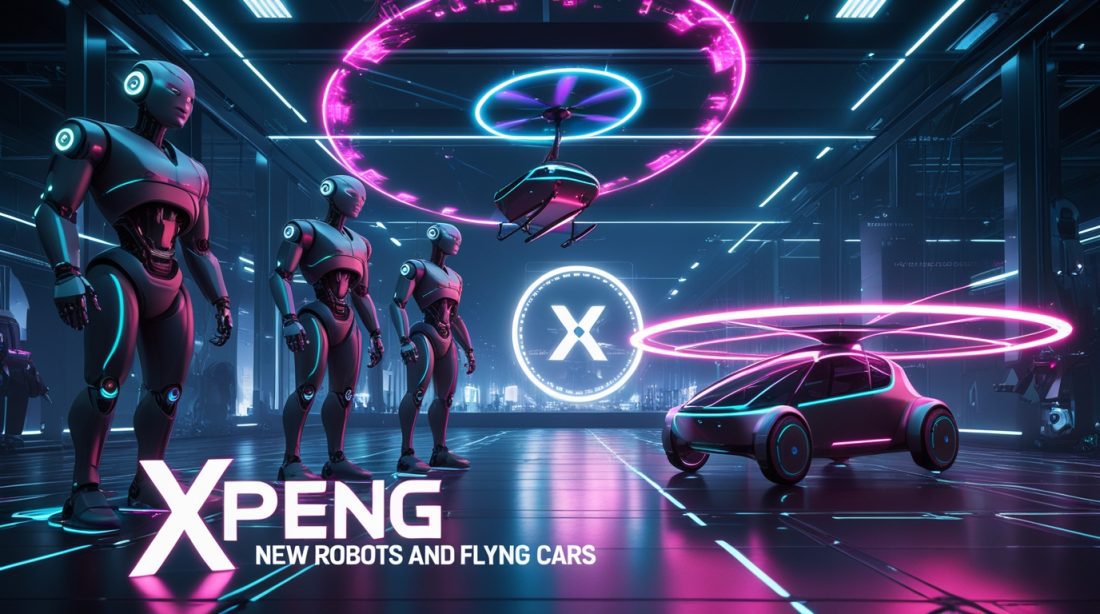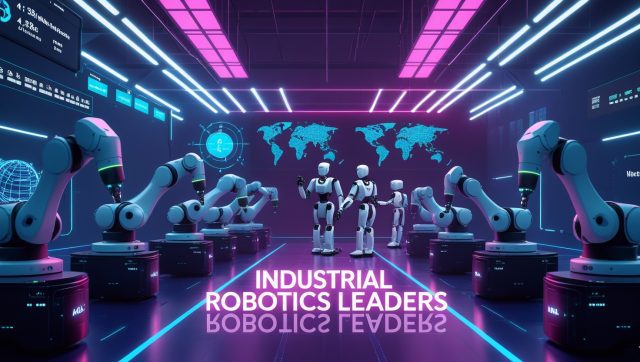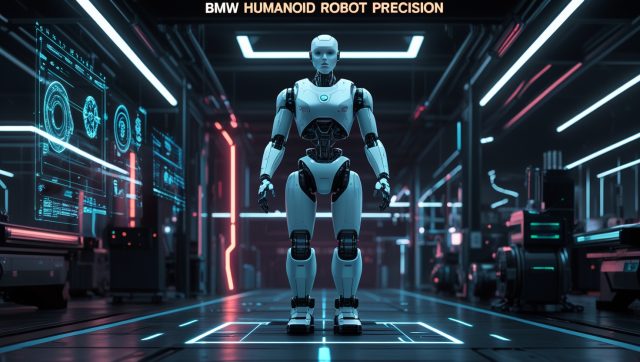Fast Facts
When XPeng unveiled its new humanoid robot, robotaxi initiative, and flying-car effort, the company didn’t just launch products—it signalled a strategic pivot in how XPeng new robots and flying cars could reshape transportation, manufacturing, and mobility ecosystems through industrial-AI (embedded intelligence in physical systems). For analysts tracking the intersection of AI and hardware, XPeng’s move demands attention.
Why this matters
XPeng’s announcement asks a central question: why should a carmaker build robots and flying cars? The answer reveals much about the transformation of industrial AI from software‐only to “physical intelligence” — intelligence embedded in movement, mechanics and mobility. XPeng is using its existing EV business as a launchpad into robotics and aerial mobility, thereby expanding the locus of industrial AI beyond factories and data centres into real-world embodied systems. For industrial AI analysts, this signals that the next wave is not just smarter machines, but machines that move, fly and interact in the physical world.
1. What did XPeng unveil?
At its “AI Day 2025” in Guangzhou, XPeng revealed four major applications under the theme of “Physical AI”:
- Its new VLA 2.0 large-model architecture (“Vision-Implicit Token-Action”) which skips the usual vision-language‐action pipeline. XPENG
- A next‐gen humanoid robot called “IRON” equipped with bionic muscles, flexible skin, an 82-degree of freedom body and three in-house Turing AI chips.
- A robotaxi programme: three purpose-built EVs slated for launch in 2026, with full stack self-developed autonomy and no LiDAR.
- Flying car/low-altitude mobility systems: including a tilt-rotor hybrid “A868” and a modular “Land Aircraft Carrier”. eWeek
2. Why is this a breakout shift in industrial AI?
2.1 From software to “seeing, moving and acting”
With VLA 2.0 XPeng replaces a language-mediated pipeline with a vision→token→action path, which implies much lower latency and more direct embodiment of intelligence. For industrial systems (robots, autonomous vehicles), this matters: the faster the perception-to-action loop, the more real-world utility.
2.2 Shared hardware/software stack across product lines
Instead of isolated silos (EVs, robotics, aviation), XPeng is deploying a unified “physical AI” stack (chips, models, hardware) across all three. This enables economies of scale and cross-domain learning.
2.3 Mobility as a platform for embodied intelligence
By entering robotaxis and flying cars, XPeng moves beyond “smart EV” to mobility platform – a key narrative of industrial-AI: embedding intelligence in platforms that serve many purposes. The robotaxi models, flying car systems, and humanoid robots all rely on embodied AI.
3. Why is the market reacting?
Shares of XPeng surged on the announcement, signalling investor belief in the scale and potential of this pivot. Yahoo Finance But the reaction isn’t just about hype—there are measurable metrics: the VLA 2.0 model trains on ~100 million clips, equivalent to ~65,000 human driving years of data. XPENG For industrial-AI watchers, data scale + hardware rollout = credible shift.
4. Why do the industrial implications extend beyond vehicles?
4.1 Robotics in industrial settings
The humanoid IRON robot is designed for service and manufacturing use-cases. XPeng has already partnered with Baosteel to deploy IRON in their plant. This shows the company isn’t only targeting consumers—industrial automation is in scope.
4.2 Aerial mobility = new infrastructure, new AI demands
Altitudes, 3D navigation, regulatory regimes: flying cars introduce new complexity for industrial AI systems. XPeng’s tilt-rotor “A868” claims 500 km range and 360 km/h speed. These are not freshman concepts—they require serious AI, hardware and systems integration.
4.3 Platform scaling impact
By opening SDKs, expecting mass production (robotaxi 2026, IRON large-scale 2026), XPeng signals it expects systems to scale. Scalability is a hallmark of industrial AI transformation.
5. Why now?
The convergence of several enablers:
- In-house chip development (Turing AI chip) giving XPeng hardware control. Wikipedia
- Large model compute scale: VLA 2.0 model with billions of parameters, 30,000-card cloud cluster. XPENG
- Market readiness: Chinese regulatory push, EV momentum, robotaxi & eVTOL ecosystems forming.
- Competitive pressure: To avoid being just another EV maker, XPeng diversifies into robotics and flying cars.
6. Why the risks matter for industrial AI watchers
Of course, big ambitions bring big risks:
- Production timelines: Robotaxis & flying cars deliver schedules are ambitious. Delays happen.
- Safety/regulation: Robotaxi with no LiDAR is bold. Safety certifications, liability regimes matter.
- Business model: Monetising robots and flying cars requires ecosystem, infrastructure, willingness to pay.
For industrial-AI analysts, these are fault-lines: technology may advance, but commercialisation is the harder part.
7. Why this matters for CreedTec’s audience
At CreedTec we write about industrial AI and the physical-world implications. XPeng’s pivot from “EV maker” to “embodied intelligence platform” gives a rich case study: how AI, hardware, mobility and robotics intersect. For our audience—engineers, analysts and decision-makers—the question isn’t only what XPeng announced, but why it matters: because the next phase of industrial intelligence isn’t just data centres and back-office automation—it’s embodied, mobile, real-world systems.
What to watch next
- The rollout of XPeng’s robotaxi fleet in China in 2026.
- Commercial deployment and pricing of IRON humanoid.
- Regulations for eVTOL/flying cars: certification, air-traffic integration.
- Competitive responses: other OEMs/robotics firms entering embodied intelligence.
- Supply-chain implications: chips, sensors, actuators for physical AI hardware.
FAQ
When will XPeng’s flying car be available?
XPeng’s tilt-rotor “A868” is in flight verification. Mass production has no confirmed consumer date yet.
What does the term “physical AI” mean in this announcement?
It refers to intelligence embedded in devices that perceive, decide and act in the physical world (robots, vehicles, flying systems) rather than just software in cloud or data centres.
Does XPeng rely on LiDAR for its robotaxi?
No – XPeng’s robotaxi strategy uses a camera-only vision stack (no LiDAR) as part of its vision-based autonomy approach.
Why is this relevant for industrial automation beyond mobility?
Because the same capabilities—vision-to-action models, embodied intelligence, integrated hardware-software stacks—are transferable to factories, logistics, service robots and more.
Final thoughts
XPeng’s unveiling of new robots and flying cars may sound futuristic, but the strategic significance is concrete. The launch of XPeng new robots and flying cars marks a decisive shift from being a “smart EV maker” to becoming a full-fledged platform of embodied intelligence. For industrial-AI professionals, the core takeaway is less about the machines themselves and more about the underlying architecture—vision-based large models, unified hardware-software stacks, and shared mobility-robotics platforms. With this move, XPeng is positioning itself right at the frontier of industrial AI transformation.
Further Reading
- AI-Powered Industrial Automation: How Rivian’s Mind Robotics is Reshaping Manufacturing
Explores how Rivian integrates AI and robotics into its factories—relevant to XPeng’s pivot toward industrial-grade automation. - Walker S2: The First 24/7 Humanoid Robot with Self-Swapping Power Modules
Links directly to XPeng’s humanoid “IRON” and the broader race toward operationally autonomous humanoids. - Why OpenAI Is Returning to Humanoid Robotics in 2025 — and What It Means for AGI
Connects XPeng’s physical-AI ambitions with the global return to humanoid robotics led by OpenAI and others. - Boston Dynamics Atlas: Humanoid Robots in Construction and Heavy Industry
Provides context for how humanoid robots are already impacting industrial work—aligning with XPeng’s IRON integration. - How AI is Finally Taming the Control Chaos of Mighty Morphing Robots
Analyzes the control and stability challenges of physical AI systems, offering readers deeper technical insight into embodied intelligence.
Subscribe to our Newsletter:
If you’re tracking how industrial AI is moving into the physical world—mobility, robotics, aerial systems—subscribe to the CreedTec newsletter to stay ahead of the transformation.



